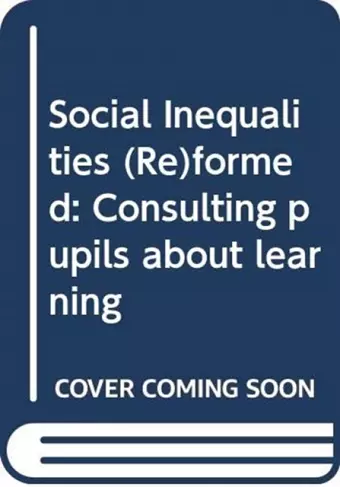Social Inequalities (Re)formed
Consulting pupils about learning
Madeleine Arnot author Diane Reay author
Format:Hardback
Publisher:Taylor & Francis Ltd
Publishing:5th Jan '26
£90.00
This title is due to be published on 5th January, and will be despatched as soon as possible.

The increasing international interest in pupil consultation has been partly fuelled by the encouragement of personalised/individualised learning strategies and the involvement of pupils in their learning.
Drawing on an in-depth study which consulted eight to fourteen year old pupils from a variety of ethnic and class backgrounds in different school settings, the book:
- offers a sociological study of learning through an exploration of the social inequalities in the control pupils have over their learning
- identifies, from a pupil’s perspective, the social conditions of learning within contemporary performance-oriented school cultures
- explores the ways in which the social conditions of learning differ for pupils according to their gender, race, social class and achievement levels
- identifies the ways in which pupils are being consulted by teachers and the social conditions for successful consultation.
This book will appeal to masters and doctoral students in gender studies and equality studies/human rights programmes, as well as academics and researchers around the world.
‘At a time when there is so much talk of co-design and personalisation in an uncritical and romantic manner by policy makers, this text will provide a much needed breath of analytical air to bear on a major policy move,’ Harry Daniels, University of Bath, UK
‘The outline indicates that this will be a valuable book that will fill a niche in an area of growing interest. In terms of the level at which this is pitched ie practice-based but presenting a strong theoretical framework, I know of no comparable book in current publication … Further, there is currently much international interest in issues of ‘student voice’ and this attention is growing (for a diversity of reasons). In the broadest sense, such ‘student voice’ and ‘student action’ interests within curriculum and pedagogy studies go beyond the intended scope of this book; in fact, the proposed book could be criticised for limiting itself to a relatively ‘safe’ end of the debate, by appearing to focus solely on ‘consulting pupils’. However, when one examines the outlined contents, it is apparent that the discussion and analysis presented here both explicitly and implicitly go beyond that, opening doors to an understanding of the ways in which students may be increasingly empowered to exercise their ‘pedagogical rights’. While practical ideas about pedagogical and curriculum reform are not canvassed, they are not far away … I would guess that the principal market for this book would still lie within the Education courses of Universities, particularly where studies of the ‘social foundations of education’ survive the pruning of educational technocrats. Most Universities within Australia that have Education Faculties would have a subject or course relevant to the topic, and/or graduate students undertaking studies in related areas. The bridge between sociological theory and practical application (pacing , choosing content, gender-related initiatives) should serve to broaden the appeal and has implications for the form of marketing within those faculties.’ Roger Holdsworth,
‘This is a timely and potentially important book:
- There is a large and growing international interest in pupil voice. However much of what is available is of the how-to variety and very little is based in empirical research which will shed light on different practices and their effects. The unpacking of ‘voice’ - as multiple, as discursive and as differently focused – will be a very helpful addition to the general debate.
- The use of Bernstein offers the possibility of bringing the question of knowledge back into discussions of learning – it is generally sadly lacking in most contemporary discussions.
- The gap between the ‘top’ and ‘bottom’ students, strongly tied to class, race and gender, is actually growing, while that between schools has narrowed. It seems as if current policy directions are actually counter to equity. As such, there is an urgent need for work which offers ways of understanding how this gap is produced. The focus on pedagogy offered in this text will be an important contribution to enhancing understanding about the re/production of inequity and what might be done.’ <
ISBN: 9780415411981
Dimensions: unknown
Weight: unknown
224 pages